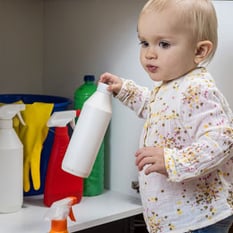 It has been a while since I have had to think about childproofing my home; however, as my younger cousins begin having children, and friends become grandparents, I thought it would be an interesting topic to research. For those of us who have older children, safety tips and recommendations have changed.
It has been a while since I have had to think about childproofing my home; however, as my younger cousins begin having children, and friends become grandparents, I thought it would be an interesting topic to research. For those of us who have older children, safety tips and recommendations have changed.
According to the CDC, more than 9.2 million children are treated in emergency departments for unintentional injuries that occur around the home. So if you’re a new parent or grandparent, here are some tips for creating a safe environment in your home.
Kitchen
- Clutter-free countertops. A child’s world is expanded significantly once he/she learns how to crawl or walk. Since a lot of time is spent in the kitchen, it is a good idea to keep as much off your countertops as possible. If you have a pantry or extra cupboard space, store your small kitchen appliances there. This will prevent kids from pulling on electrical cords. Also, keep silverware away from the edge of the countertop.
- Use the back burners. Young kids love to reach and pull themselves up on things. By using the back burner, pot, and pan handles will be out of sight and out of mind.
- Use the middle of the counter. Put hot pots, pans, slow cookers, and cookie sheets in the middle of the counter. Again, this will prevent kids from pulling things down on top of them.
- Install safety latches/oven locks. If you do not have room to store household products out of reach, install safety latches on kitchen cabinets. In addition, cover your oven dials if they are located on the front of your oven. Lastly, install a lock on the oven door.
Livingroom
- Secure your flat-screen TV. TV straps are available to anchor your TV to the wall or the TV stand itself. If you are securing it to the wall, make sure you attach it to a stud.
- Secure your book self. If you have a bookshelf that is taller than it is wide, secure it to a stud in the wall.
- Add corner cushions. Nice coffee and end tables can spruce up your living room; however, tables with sharp corners can cause serious injury if your child falls.
- Cover the indoor ice rink. If you have hardwood or ceramic tile floors, they can be very slippery. To soften the blow from a fall, you may lay down a rug. However, unless the rug is laid on a non-slip rug pad, the rug may still move around and cause a fall.
- Install outlet covers. When my kids were small, I used plastic plugs in the outlet. They worked fine for my family. The problem with them is if you take one out and forget to put it back, it can turn into a choking hazard and your electrical outlet is left exposed. Today’s parents and grandparents can purchase self-closing outlet covers. When the vacuuming is done, you can unplug and move on to your next chore. The outlet automatically closes for you.
- Make sure window-covering cords are out of sight. To learn more about protecting your children from strangulation check out the article, “Are Your Window Coverings Safe?"
Bathroom
- Consider an anti-scald faucet. Water heaters’ default temperature settings range from 120 to 140 degrees Fahrenheit. If yours is set at the high end, three seconds is all it takes for a serious burn. Anti-scald faucets can take the guesswork out of bathing your child by providing a consistently safe temperature. Another alternative is to turn down the temperature on your water heater.
- Install a spout cover. Spout covers come in a variety of shapes and sizes to meet the requirements of your tub.
- Keep your bathroom door locked. There are many hazards in an everyday bathroom. If possible, your best bet is to keep the door locked.
Bedroom
- Install a window guard(s). If you live in a two-story house and like to keep your windows open on nice days, window guards are necessary. The screens on the windows are flimsy and were made to keep insects and other debris from entering. They were not made to support the weight of a child pushing on them.
- Follow the same tips for the living room section. In addition, it’s a good idea to anchor dressers too.
Check out this video from This Old House. I found it interesting to see how safety devices have improved over the years.
Do you have any suggestions or information you’d like to share? I’d love to hear from you. Please share them in the box below.
Sources:
http://www.cpsc.gov/en/Safety-Education/Safety-Guides/Kids-and-Babies/Childproofing-Your-Home--12-Safety-Devices-To-Protect-Your-Children/
http://www.burnfoundation.org/programs/resource.cfm?c=1&a=3
http://parent.guide/
http://www.cdc.gov/safechild/Child_Injury_Data.html





